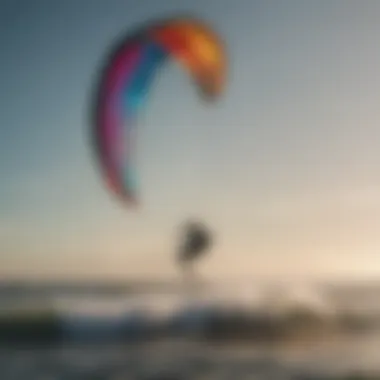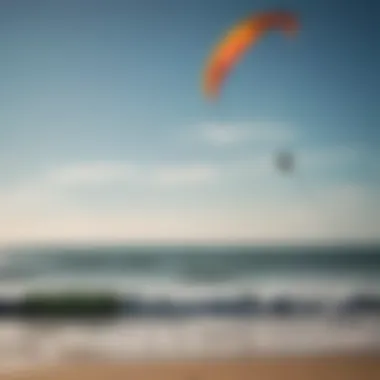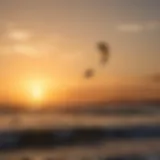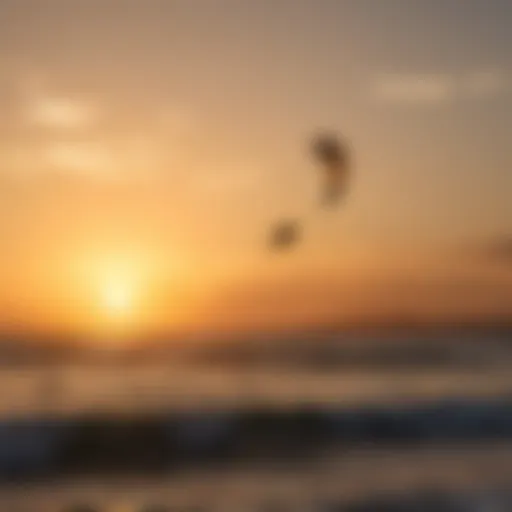Unlocking the Secrets to Choosing the Perfect Kite for Your Adventure


Equipment Reviews
Kites have evolved significantly over the years, with manufacturers continually pushing the boundaries in design and performance. Evaluating the latest kite models involves examining various aspects such as shapes, sizes, materials, and brands. Each factor plays a crucial role in determining how a kite will perform in different conditions. From hybrid shapes that blend characteristics of C-shaped and bow kites to the versatility of delta shapes, there is a wide array of options to cater to diverse riding styles and skill levels.
When it comes to kiteboarding boards, riders can choose from twintips, suitable for freestyle and versatility, to directional boards designed for wave riding. The design elements and construction of boards greatly influence ride quality and performance. Factors like flex, rocker, and board length all contribute to how a board handles in various water conditions. Brands offer unique technology and innovation, providing riders with options to match their preferences and riding goals.
Essential kiteboarding accessories go beyond the kite and board, encompassing crucial gear for a safe and enjoyable session. Harnesses, lines, pumps, and safety equipment are vital components of any kiteboarding setup. A harness ensures proper weight distribution and minimizes strain on the body during rides, while quality lines and pumps help maintain kite control and inflation efficiency. Safety gear like helmets and life jackets are non-negotiable to mitigate risks on the water, underlining the importance of investing in high-quality accessories.
Understanding Kite Specifications
In the realm of kitesurfing and kiteboarding, understanding kite specifications is paramount. As enthusiasts embark on the quest to find the ideal kite, delving into the intricacies of kite specifications unveils a world of essential information. These specifications serve as the blueprint that depicts the kite's performance, handling, and overall suitability for varying riding styles and conditions. By honing in on kite specifications, enthusiasts can decipher crucial details like size, aspect ratio, leading edge, trailing edge, canopy material, and construction.
Kite Size and Aspect Ratio
When it comes to selecting the right kite, size and aspect ratio play pivotal roles in determining the kite's behavior on the water. The kite's size directly influences its power generation and responsiveness to wind conditions. A larger kite provides more power, making it ideal for lighter winds, while a smaller kite offers greater maneuverability and control in stronger winds. Aspect ratio, on the other hand, pertains to the ratio of the length of the kite's leading edge to its width. High aspect ratio kites excel in upwind performance and speed, whereas low aspect ratio kites are known for their stability and ease of use. Understanding these factors is crucial in choosing a kite that aligns with one's riding style and skill level.
Leading Edge and Trailing Edge
The leading edge and trailing edge of a kite are integral components that significantly impact its flight characteristics and performance. The leading edge, located at the front of the kite, plays a key role in maintaining the kite's aerodynamic shape and stability during flight. A well-designed leading edge enhances the kite's lift and responsiveness, contributing to a smoother ride experience. Conversely, the trailing edge, situated at the back of the kite, influences its efficiency in generating power and controlling speed. By grasping the distinct functions of the leading and trailing edges, riders can better comprehend how these elements shape the kite's behavior on the water.


Canopy Material and Construction
The canopy material and construction of a kite are vital aspects that determine its durability, performance, and longevity. Kite canopies are typically crafted from ripstop nylon or polyester fabrics known for their strength, tear resistance, and lightweight properties. The construction of the canopy, including the placement of panels, seams, and reinforcements, impacts the kite's aerodynamics and structural integrity. A well-constructed canopy enhances the kite's stability, responsiveness, and overall quality, ensuring a reliable and enjoyable riding experience. By scrutinizing the canopy material and construction, riders can make informed decisions when selecting a kite that meets their performance expectations and withstands the rigors of kitesurfing and kiteboarding adventures.
Types of Kites for Different Riding Styles
In the realm of kitesurfing and kiteboarding, understanding the various types of kites designed for different riding styles is crucial. Each type of kite offers distinct characteristics and benefits tailored to specific preferences and skill levels. When delving into the realm of kite selection, factors such as performance, control, and versatility play a pivotal role in determining the most suitable option. By exploring the diverse landscape of kites available on the market, enthusiasts can make well-informed decisions based on their individual riding style and preferences.
Bow Kites vs. C-Kites
Bow kites and C-kites stand as two primary categories within the spectrum of kite designs, each catering to different styles of riders. Bow kites, also known as delta kites, are renowned for their user-friendly nature and versatility, appealing to beginners and intermediate riders seeking stability and ease of relaunch. On the other hand, C-kites, characterized by their more aggressive performance and direct feel, are favored by advanced riders looking to execute advanced tricks and maneuvers with precision. By understanding the nuanced differences between bow kites and C-kites, riders can align their choice with their skill level, riding style, and performance expectations.
Hybrid Kites and Foil Kites
Hybrid kites and foil kites emerge as innovative alternatives that blend features of different kite designs to offer a unique riding experience. Hybrid kites combine aspects of both bow and C-kites, harnessing the stability of bow kites with the performance characteristics of C-kites. This hybrid approach appeals to riders seeking a balance between user-friendliness and advanced performance. Conversely, foil kites, recognized for their lightweight construction and exceptional efficiency in light wind conditions, cater to riders looking to maximize their time on the water in variable weather conditions. By evaluating the benefits and trade-offs of hybrid kites and foil kites, enthusiasts can select a kite that aligns with their riding preferences and environmental conditions.
Inflatable vs. Soft Kites
The choice between inflatable and soft kites hinges on factors such as wind range, durability, and handling characteristics. Inflatable kites, characterized by their inflatable leading edge and struts, provide stability, efficient relaunch capabilities, and versatility across a broad wind range. Conversely, soft kites, which lack rigid support structures, offer lightweight construction and simplicity in setup, making them ideal for riders prioritizing portability and ease of use. By weighing the attributes of inflatable and soft kites, riders can pinpoint the option that complements their riding style, wind conditions, and overall preferences.


Factors to Consider Before Buying a Kite
Choosing the right kite is crucial for kitesurfing and kiteboarding enthusiasts looking to maximize their performance and safety on the water. Before making a purchase, several factors need to be carefully considered to ensure that the kite aligns with the rider's abilities and preferences. Skill level, riding conditions, budget, value for money, brand reputation, and customer reviews are all key elements that play a significant role in the selection process.
Skill Level and Riding Conditions
A fundamental aspect to contemplate when purchasing a kite is the rider's skill level and the intended riding conditions. Different kites cater to varying expertise levels, from beginner-friendly kites designed for learning the basics to high-performance kites intended for advanced riders seeking adrenaline-fueled maneuvers. Additionally, the type of riding conditions prevalent in the area where the kite will be used, such as strong winds or choppy waters, greatly influence the choice of kite. Choosing a kite that matches both skill level and riding environment is essential for a successful and enjoyable kitesurfing experience.
Budget and Value for Money
In the realm of kitesurfing and kiteboarding, budget considerations are paramount when selecting a kite. Balancing the desired quality and features of the kite with the available budget is a vital aspect of the decision-making process. While high-end kites may offer advanced technology and performance benefits, budget-friendly options can also provide adequate functionality for riders on a tighter budget. Assessing the value for money involves determining if the kite's price aligns with its quality, durability, and performance, ensuring a satisfactory investment in the long run.
Brand Reputation and Customer Reviews
Exploring the reputation of kite brands and evaluating customer reviews can provide valuable insights into the quality and reliability of a particular kite model. Established brands with a history of producing high-quality kites are often preferred for their consistency and innovation in kite design. Customer reviews offer firsthand experiences and feedback on the performance, durability, and overall satisfaction with a kite, aiding prospective buyers in making informed decisions. Considering brand reputation and customer reviews contributes to selecting a kite that meets expectations and delivers a rewarding kitesurfing or kiteboarding experience.
Popular Kite Brands in the Market
In the competitive world of kitesurfing and kiteboarding, the significance of choosing reputable kite brands cannot be overstated. Popular kite brands offer a blend of quality, innovation, and performance that set them apart from lesser-known competitors. When selecting a kite, riders often look towards established brands for reliability, durability, and advanced technology that can enhance their overall experience on the water.


North Kiteboarding
North Kiteboarding stands out as a powerhouse in the kite market, known for its cutting-edge designs and high-performance kites. With a reputation for pushing boundaries and leading advancements in kite technology, North Kiteboarding offers riders a range of options tailored to different skill levels and riding styles. Their kites are crafted with precision and attention to detail, ensuring a smooth ride and optimal control in various wind conditions.
Cabrinha Kites
Cabrinha Kites has earned a loyal following among kitesurfers worldwide due to its commitment to producing kites that deliver exceptional performance and versatility. Whether you're a freestyle enthusiast or a wave rider, Cabrinha has a kite designed to suit your preferences. Renowned for their stability, power, and responsiveness, Cabrinha kites are favored for their reliability in challenging wind conditions, making them a popular choice for riders seeking consistency and control.
Slingshot Kiteboarding
Slingshot Kiteboarding is synonymous with innovation and quality in the kiteboarding community, offering riders dynamic and reliable kites that cater to a diverse range of styles. From beginner-friendly options to high-performance kites for advanced riders, Slingshot kites are known for their durability, ease of use, and cutting-edge design features. With a focus on enhancing the riding experience through top-notch craftsmanship and engineering, Slingshot Kiteboarding continues to be a top choice for riders looking to elevate their performance on the water.
Tips for Maintaining and Extending the Lifespan of Your Kite
In the realm of kiteboarding, ensuring the longevity and optimal performance of your kite is paramount. This section delves into the indispensable practices that aid in safeguarding your investment and preserving the functionality of your equipment over time. By implementing these meticulous strategies, enthusiasts can elongate the lifespan of their kites while upholding safety standards and enhancing their riding experience.
Proper Storage and Transportation (250-300 words)
One of the foundational pillars of proper kite maintenance is adequate storage and transportation. After a thrilling session on the water, meticulously storing your kite in a safe environment is crucial to mitigate wear and tear. Shielding the fabric from sunlight exposure, moisture, and abrasive surfaces is imperative in preventing premature aging of the material. Additionally, storing the kite in a dry, well-ventilated area helps thwart mold or mildew, which can compromise the integrity of the kite over time. When it comes to transportation, utilizing purpose-built bags or covers to shield the kite from friction during movement is key to preserving its structural integrity and aerodynamic shape. By adhering to these storage and transportation best practices, riders can safeguard their kites from avoidable damage and degradation, ensuring longevity and maintaining peak performance.
Regular Inspections and Repairs (250-300 words)
Regular inspections and proactive repairs are integral components of kite maintenance that contribute significantly to its lifespan. Conducting routine examinations of the kite's seams, lines, and bridles enables riders to detect potential issues such as fraying, tears, or weakened components early on. Timely identification of these issues not only prevents accidents but also facilitates swift repairs, minimizing the extent of damage and associated costs. Investing in high-quality repair materials and adhesives empowers riders to address minor damages promptly, extending the kite's longevity and averting more significant repairs down the line. Moreover, being attuned to the kite's condition through regular inspections fosters a proactive maintenance approach, allowing riders to ensure peak performance and safety while maximizing the kite's lifespan for continued enjoyment on the water.
Avoiding Harsh Weather Conditions (250-300 words)
Mitigating the impact of harsh weather conditions is a crucial aspect of preserving your kite's lifespan and optimizing performance. Exposure to extreme weather elements such as strong winds, heavy rain, or excessive sunlight can accelerate the degradation of kite materials, leading to diminished structural integrity and performance capabilities. When not in use, storing the kite in a climate-controlled environment shields it from temperature fluctuations and excessive humidity, safeguarding against premature wear and tear. Additionally, being mindful of forecasted weather conditions and refraining from launching the kite in adverse scenarios helps prevent damage caused by gusty winds, storms, or abrasive surfaces. By exercising prudence and mindfulness in relation to weather conditions, riders can prolong their kite's lifespan, uphold its pristine condition, and ensure a safe and exhilarating kiteboarding experience for years to come.







